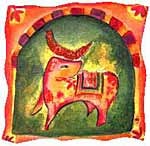冯家人祝贺你们!
新年快乐!
Happy 牛(Niu)Year of the Ox!
Gott Nytt År!

Wishing you all well and the best of health!
May you and everyone that is dear to you prosper and thrive during this
new
Year of the Ox!
We are in the middle of the spring festivities of the Chinese New Year. 25-31 January 2009
If you like to find out what Animal sign that corresponds to your birthdate you can
consult this quick and dirty concordance to the Chinese Animalsigns.
There are some finer details to scrutinize for those born in the beginning
of the year. i.e jan-feb to see if you belong to the previous Chinese year.
Lets hope that there will be no more "mala leche" and that this year will bring the good milk to China
like one can still enjoy in the streets of Triplicane in Madras.

iniya puthandu nal Vazhthukkal
牛

There is one more thing you should know about oxen!
They look calm and placid when they eat but don't doublecross them!
It would seem possible to celebrate all sorts of new years. But I guess it is a little like the problems of standards, how many can you have and still call them standard? It is however some sort of consolation that if you seem to get stuck with a particularily obdurate year, you can jump to another reckoning of time, start over with a clean slate and get another totally unused year, be it 2009, 1427, etc. etc.
* As for the Gregorian Calender Sweden has a curious history. Sweden decided to make a gradual change from the Julian to the Gregorian calendar. By dropping every leap year from 1700 through 1740 the eleven superfluous days would be omitted and from 1 Mar 1740 they would be in sync with the Gregorian calendar. (But in the meantime they would be in sync with nobody!)
So 1700 (which should have been a leap year in the Julian calendar) was not a leap year in Sweden. However, by mistake 1704 and 1708 became leap years. This left Sweden out of synchronisation with both the Julian and the Gregorian world, so they decided to go ‘back’ to the Julian calendar. In order to do this, they inserted an extra day in 1712, making that year a double leap year! So in 1712, February had 30 days in Sweden.
Later, in 1753, Sweden changed to the Gregorian calendar by dropping 11 days like everyone else.
For more history on attempts at measuring the unmeasurable and further ideas on more onedimensional descriptions of time I highly recommend this link:
http://calendopedia.com


